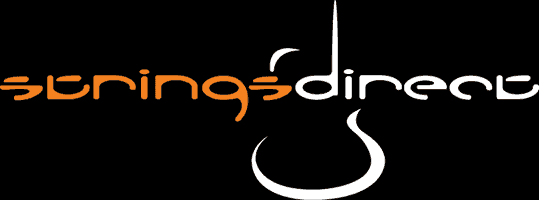What are the best guitar strings for blues?
By Strings Direct – 29 August, 2023
 The blues is such a broad genre of music that it would be difficult and wrong of us to say there is just one set of strings that are the best guitar strings for blues.
Instead, in this guide we’ll offer up some thoughts and suggestions on the numerous facets of electric guitar strings and look at how your choice can help to benefit your development and style of playing the blues.
Without further ado, let’s get into it……
The blues is such a broad genre of music that it would be difficult and wrong of us to say there is just one set of strings that are the best guitar strings for blues.
Instead, in this guide we’ll offer up some thoughts and suggestions on the numerous facets of electric guitar strings and look at how your choice can help to benefit your development and style of playing the blues.
Without further ado, let’s get into it……
Gauge
Arguably, the most significant thing to consider when selecting a set of electric guitar strings is which string gauge you’ll want to choose. String gauge can be a vast topic to cover, but in a nutshell it refers to how thick the strings are. Each string has a numerical value that represents how thick it is and the higher the number, the thicker the string will be. When it comes to sets, you’ll often see them written like this; 09-42, 10-46, 11-49 etc. This range gives an overview of the gauges within each set. The smaller number refers to the 1st string (thinnest) in the set and the larger number is the 6th string (thickest) in the set. Using this info, we can see that the strings within a 09-42 set are thinner than those found in a 10-46 set. Blues guitar has always been a genre focused around expression, and a few of the ways in which blues players express their individuality is through their use of bending and vibrato. Your gauge choice can be a huge factor in helping you achieve your own style. The lighter the gauge (i.e. the thinner the string), the easier the strings are to bend and add vibrato to. On the flip side, heavier gauge strings are thicker in diameter meaning they have more tension in them resulting in a stiffer feeling string. This can make bends and vibrato a little more challenging and they may start to feel a bit tougher on the hands. That being said, heavier gauge strings can really help to add more depth and body to your overall tone. The theory behind this is that the more steel there is in the string, the greater the mass and more magnetic pull there is from the pickups resulting in higher output and therefore a "bigger and better" tone. We are big believers that better technique delivers better tone in the long run. That’s why it’s important to select a gauge that you’re comfortable with and one that will allow you to develop and improve your technique. Don't overstretch yourself here.
If you’re just starting out or simply not sure which gauge to go for, we’d always encourage players to start with a 9-42 or 10-46 gauge. These are ideal gauges as they allow you to concentrate on developing your chops without getting too bogged down with sore hands and building up fatigue. If in time you feel you’ve ‘outgrown’ lighter gauges, you can always go heavier. Above all, it’s important to go with what’s right for you! As much as we like to emulate our heroes, over time it’s important to settle on a gauge that’s best for your style, not somebody else’s. Speaking of which…..
For those Stevie Ray Vaughan fans out there, some of your heads may have been turned by his outrageously heavy strings. Whilst the heavier gauge certainly helped deliver SRV’s monster tone, a set of strings this heavy needs to be approached with caution. They’re certainly not “fingertip friendly” and playing a set this heavy can prove tough work. They can also put excess stress on your hands (and guitar) so be prepared for a few trips to the physio after playing a a few gigs with these strings!
We wrote a blog post all about the joys of light gauge strings titled "I like light strings and I cannot lie!" you can check that out here.
We are big believers that better technique delivers better tone in the long run. That’s why it’s important to select a gauge that you’re comfortable with and one that will allow you to develop and improve your technique. Don't overstretch yourself here.
If you’re just starting out or simply not sure which gauge to go for, we’d always encourage players to start with a 9-42 or 10-46 gauge. These are ideal gauges as they allow you to concentrate on developing your chops without getting too bogged down with sore hands and building up fatigue. If in time you feel you’ve ‘outgrown’ lighter gauges, you can always go heavier. Above all, it’s important to go with what’s right for you! As much as we like to emulate our heroes, over time it’s important to settle on a gauge that’s best for your style, not somebody else’s. Speaking of which…..
For those Stevie Ray Vaughan fans out there, some of your heads may have been turned by his outrageously heavy strings. Whilst the heavier gauge certainly helped deliver SRV’s monster tone, a set of strings this heavy needs to be approached with caution. They’re certainly not “fingertip friendly” and playing a set this heavy can prove tough work. They can also put excess stress on your hands (and guitar) so be prepared for a few trips to the physio after playing a a few gigs with these strings!
We wrote a blog post all about the joys of light gauge strings titled "I like light strings and I cannot lie!" you can check that out here.
Speed
String gauge can also affect the speed at which you're able to play. If you like to move up and down the fingerboard with lightning speed, a lighter gauge will certainly allow you to glide between the strings at a faster and more fluid pace. Thicker strings require extra energy to fret, bend, hammer-on and pull-off the notes meaning moving between the strings will feel more challenging. Certainly something to bear in mind if you're partial to 5-minute epic blues solos... these may start to feel quite laboured (and possibly painful) after a while if you're using heavy strings. However, if you’re a ‘less is more’ kind of player and like to wring every last ounce of tone from each note, a heavier gauge could suit your style if you're not moving rapidly around the neck. A thicker string will help adding that extra bit of energy and power to your bends and vibrato and will also allow you to 'dig in' with your right hand for that extra bit of 'growl' when raking across the strings.
Hybrid Gauges
It’s worth mentioning that if you choose to go for a lighter gauge set, the thicker strings in that set will be lighter too. If you like to dabble in a bit of rhythm playing, you may feel that lighter gauge strings means sacrificing tone on the thicker strings (aka the bottom / low end). To help overcome this, there’s always the option of choosing a hybrid gauge set (aka a lighter top/heavy bottom set). These sets take the three treble strings from a lighter set and blend them with the thicker three strings from a heavier set. For example, 09-46 is a popular hybrid gauge set and contains the following gauges - 09, 11, 16, 26, 36, 46. The individual strings in this set are a mix of the thinner treble strings in a 09-42 set…. 09-42 set - 09, 11, 16, 24, 32, 42. … Combined with the thicker bass strings from a heavier gauge 10-46 set 10-46 set - 10, 13 , 17, 26, 36, 46. Many players prefer these hybrid gauges as they offer the best of both worlds... heavier bass strings to add a bit of depth combined with thinner treble strings to help make bends and vibrato a little easier.
Blues Tunings
For some blues players, they’re quite content to remain in standard tuning. However, if you’re an avid blues fan, you’ll no doubt like to explore other alternatives. A common tuning favoured by ‘blues’ and ‘blues-rock’ players is to tune down by half a step to Eb (E flat). What does this mean exactly? This is where all six strings are tuned down by one semitone. So the low E (6th string) will go down to Eb, with the other 5 strings following suit (Eb, Ab, Db, Gb, Bb, Eb). This has been a popular move for many blues players including Jimi Hendrix and Stevie Ray Vaughan. Eb tuning can really help give the sound a little bit more attitude. Dropping the tuning by just half a step also creates a little bit of 'slack' in your strings making them feel a little bit looser and buttery under the fingers. Mmmm The people that benefit the most from this tuning are the vocalists in blues bands, particularly those who struggle to reach the higher registers. Hendrix and SRV not only tuned down half a step for the tonal benefits, but more importantly, it meant they could sing in a more comfortable register without the need for wearing tighter jeans or tying an elastic band around their knackers!! If you’re tuning down but not too keen on the thought of your strings feeling ‘looser’, it’s worth choosing a set with a slightly heavier gauge as the extra tension will offset against the lower tension that comes from tuning down. For example, if you’re used to playing 9’s and wish to tune down half a step, going up a gauge to a set of 10’s (10-46 gauge) will help you maintain that similar feel and tension to the 9's when they were in standard tuning.Material
Nowadays, if you pick up any set of electric guitar strings, there’s a good chance the thicker wound strings will be wound with Nickel Plated Steel. This wrap material has been the most popular choice for many string brands since the ’60s and ’70s. Nickel-plated steel strings give a bright and punchy tone so will suit most styles of electric blues playing. If you’re playing in a band, they’ll also offer the right amount of oomph and help you to cut through the mix nicely. Whether you play in a 3-piece power trio, or in a bigger band competing with other instruments a set of Nickel Plated steel strings will be a sound choice. Of course, there are plenty of other materials to choose from too. Back in the ’60s, most blues players would have used Pure Nickel or Monel strings. Pure Nickel and Monel strings offer a distinctly warmer tone in comparison to Nickel Plated steel, making them a great option for players looking to capture those vintage blues vibes. They’re also a good choice if you find yourself looking to tame a brighter sounding instrument. If you’ve ever been on the receiving end of a brittle sounding bridge pickup, you’ll know what we mean here!
Construction
When we talk about the construction of strings, we’re referring to the outer winding found on the wound strings. For electric guitar sets, this winding typically comes in three forms; round wound, half round, and flat wound. The variations between these different types of windings affect the way the string feels under your fingers and the way it sounds. If you’re unsure of what to go for, we’d always recommend starting with a round wound string. Most brands’ flagship electric sets are wound in this way so they are readily available in all the most popular gauges too. Round wound strings deliver a nice, balanced brightness and they also help enhance sustain too. Their brighter tone also helps add that extra bit of power needed when you crank it up for those all-important blues solos. As mentioned before, Stevie Ray Vaughan was known to have used GHS Nickel Rockers. The GHS Nickel Rockers are a good example of a half round string (they call them Rollerwound) where the wound strings have a smoother feel to the touch and also offer a mellower tone in comparison to standard round wound strings. They are constructed firstly by taking a round wound string and using specially constructed pressure rollers (hence the rollerwound name), they are flattened off slightly during the manufacturing process. Some players also prefer the smoother feel as it helps reduce the finger squeak you get as you run your fingers up and down the strings…. something that can stand out like a sore thumb especially at higher volumes. Half rounds can also be a good option if you’re looking to tone down a brighter sounding guitar. If these were good enough for Stevie, they’re good enough for anybody in our book….. Of course, you may even wish to take this a step further and choose a flat wound string. These strings are typically favoured by jazz players as they have a completely smooth surface which makes for a warm, mellow tone. On the face of things, flatwound strings don’t really lend themselves to what you'd call typical blues playing, however, there's plenty of players who have "bucked the trend" in the past so it's always worth experimenting. For instance, Albert King was known to have used flats during his career and modern blues guitarist Gary Clark Jr is said to be a big fan of the D’Addario ECG24 11-50 Flatwound set.
Core Shape and Size
One of the final options you can make a choice on is the shape of the central core in your wound strings. Core shape is an area which is often overlooked but can certainly impact the way your strings feel. There are two main core shapes used in guitar strings today; hex core and round core. From a blues-playing perspective, both core types are perfectly suitable options but it's worth noting that both have their own unique subtle characteristics. In short, hex core strings have a slightly stiffer feel and will offer a bit more brightness, whereas round core strings have a softer feel and help to give a warmer, boomier tone. Hex core strings are by far the most widely used and are found in many popular electric guitar string sets. Unbeknown to you, hex core strings are likely to be what you will have used in the past. Whilst round cores are less common they're an interesting alternative. For players using lighter gauges, round cores can help give that extra bit of body to your tone. They also benefit from extra flexibility so could certainly be a viable option for those blues players looking for a slinkier feel to their strings. A lot of GHS' electric guitar strings are wound over a round core as are American string makers DR's Pure Blues range. These strings are round wound with Pure Nickel over a round core. DR describe these as a 'vintage' string as almost every element used goes against what you would call 'the norm' in modern string making.... a popular string for those in the know!
The differences between the two core shapes is subtle so won't have such an obvious effect on your tone compared to something such as string material. That being said, if you’re looking to hone in on that perfect set of strings for your blues playing, it’s certainly worth testing a few different sets out. You can check out a list of all the round core sets we stock here.
If you’d like some more in-depth information on the core shapes, feel free to check out our blog post “What’s the difference between hex core and round core strings?”
Whilst round cores are less common they're an interesting alternative. For players using lighter gauges, round cores can help give that extra bit of body to your tone. They also benefit from extra flexibility so could certainly be a viable option for those blues players looking for a slinkier feel to their strings. A lot of GHS' electric guitar strings are wound over a round core as are American string makers DR's Pure Blues range. These strings are round wound with Pure Nickel over a round core. DR describe these as a 'vintage' string as almost every element used goes against what you would call 'the norm' in modern string making.... a popular string for those in the know!
The differences between the two core shapes is subtle so won't have such an obvious effect on your tone compared to something such as string material. That being said, if you’re looking to hone in on that perfect set of strings for your blues playing, it’s certainly worth testing a few different sets out. You can check out a list of all the round core sets we stock here.
If you’d like some more in-depth information on the core shapes, feel free to check out our blog post “What’s the difference between hex core and round core strings?”
Conclusion
We hope this guide has helped demystify some of the different characteristics of guitar strings and allowed you to see that there are so many elements you can explore to achieve that elusive holy grail of blues tone. We know there’s a lot of info to take in here. If you’re still unsure of what set to go for, a good starting point would be to choose a popular gauge from one of the bigger string manufacturers such as Ernie Ball, D’Addario, GHS, Elixir or Rotosound. Any of these brands will be a great starting point. They won’t break the bank and will give you a great springboard on which to explore other types of strings. We’ve included links to a few of the most common sets below which will link you directly to the relevant page on our website. Above all, it’s worth remembering that it’s important to find your own voice and be sure to use whatever set works for you. If you need some more guidance, feel free to call us on 01702 540068 or drop us an email at info@stringsdirect.co.uk. We’re always happy to offer advice and guidance where we can.Popular 09-42 gauge sets
Ernie Ball 09-42 Super Slinky Nickel Wound Strings D'Addario EXL120 09-42 Nickel Wound Strings Legacy 09-42 Nickel Wound Strings GHS Boomers 09-42 Nickel Wound Strings (Round Core Set)Popular 09-46 gauge sets (a great hybrid gauge set)
Ernie Ball 09-46 Hybrid Slinky Nickel Wound Strings D'Addario EXL125 09-46 Nickel Wound Strings Legacy 09-46 Nickel Wound Strings GHS Boomers 09-46 Nickel Wound Strings (Round Core Set)Popular 10-46 gauge sets
Ernie Ball 10-46 Regular Slinky Nickel Wound Strings D'Addario EXL110 10-46 Nickel Wound Strings Legacy 10-46 Nickel Wound Strings GHS Boomers 10-46 Nickel Wound Strings (Round Core Set)Popular 11-49 gauge sets (if you fancied something a bit heavier)
Ernie Ball 11-48 Power Slinky Nickel Wound Strings D'Addario EXL115 11-49 Nickel Wound Strings Legacy 11-48 Nickel Wound Strings GHS Boomers 11-50 Nickel Wound Strings (Round Core Set)




